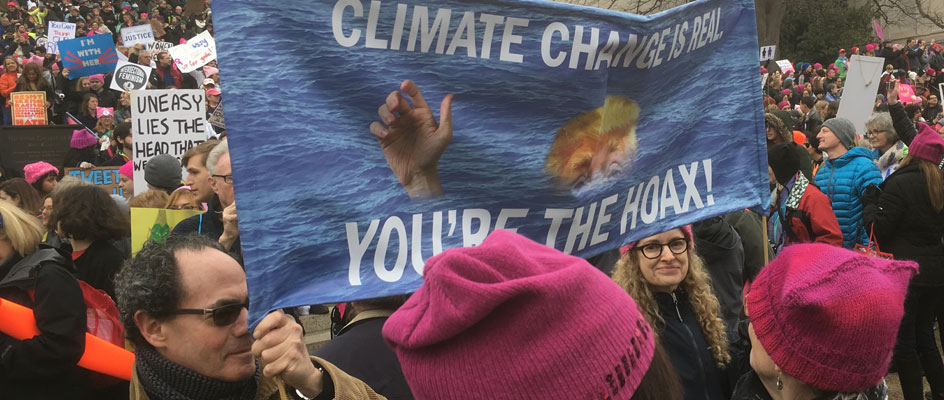The Blazing World
by Tan Copsey

Edward Hicks. Noah’s Ark. 1846. Oil on canvas. 26 1⁄4 × 30 1⁄2 in. Philadelphia Museum of Art.
This article appears in Even no. 6, published in spring 2017.
All across Washington this winter, climate organizations totally unprepared for the election of Donald Trump have quietly canceled events, dejectedly scrapped their campaigns, hastily rewritten their policy papers. I’ve spent my entire adult life working to slow global climate change, and now, forced to take stock of the irreversible damage his victory may entail, it’s clear that the last ten years were actually boom times for clean energy and environmentalism. From China to Saudi Arabia, vast quantities of wind and solar energy were produced, driving prices through the floor. Tesla began work on a “gigafactory” in the Nevada desert, doubling the worldwide production of lithium ion batteries. Coal companies have collapsed. And after years of arguments in tents, stadiums and gray conference centers on the edges of Warsaw, Lima, and Doha, we finally pieced together an international deal on climate change in Paris one year ago. It’s hard to get 197 countries to agree on the time of day, so the Paris Agreement was a feat of diplomatic endurance, the work of men and women with a tolerance for repetition, stale food and worse coffee. The last time I picked up my UN badge, the woman at the desk laughed as she saw my picture, taken in 2008. “What happened to you?”
Now all that work may be wiped out. Before the election, the International Energy Agency projected that 30,000 solar panels would be installed every hour, around the world, for the next five years. Under a Trump presidency — and with an Environmental Protection Agency led by Scott Pruitt, a climate-change denier who made his name attacking that very agency — we now risk spending the next four years building the wrong things, and being stuck with them for far longer. Coal power plants emit greenhouse gases for an average of 40 years, while a new gas-guzzling 4x4 lasts at least ten. Trump may subsidize both, creating a short-term economic boost, followed by billions in long-term damage.
At the same time the planet will continue to warm. 2016 is on course to be the hottest year in history, as was 2015, as was 2014. Global sea ice has melted to an all-time low. And while climate change often sounds abstract and distant, these changes are already hurting people; we climate activists meet them all the time. In rural Sumatra, one of my colleagues met a man who’d stopped sleeping, plagued by the memory of the floods that come with increasingly unpredictable heavy rain. In coastal Bangladesh, cows were skinnier and people were going hungry as the rising sea salted their farmland. Human beings are adaptable, but millions of us are simply not ready for the consequences of accelerated warming. Though one noted climate denier is getting organized: Trump has been quietly trying to fortify one of his golf courses in Ireland against the rising tide.

“The concept of global warming,” Trump has informed us (via Twitter, of course), “was created by and for the Chinese in order to make US manufacturing non-competitive.” Now he is in a position to peddle such disinformation from on high. Early indications are that his administration will make cuts to NASA’s earth sciences division, which provides crucial satellite verification for trends observed by weather stations on land. It’s easier to believe that climate change is a Chinese hoax when NASA isn’t telling you otherwise. As the man himself says, “It’s a very complex subject. I’m not sure anybody is ever going to really know.” And if people never really know whether climate change is a problem, then why should the American government and American businesses act?
There are some hopeless optimists among our brigade of climate wonks, still holding out hope that a great big program of building things — new nuclear power plants and energy-efficient skyscrapers — might appeal to the Trump team. (A Finnish colleague tells a story of taking members of that country’s populist party up to the Arctic, to get them to see melting up close.) But it is a pipe dream to imagine that Republicans already cutting funds for wind farms and touring the Alberta tar sands will change their tune, and so think-tankers in pastel shirts are instead gearing up for a fight. After years comfortably working on the inside, discussing policy proposals with presidents and CEOs, this will come as a shock. Luckily, part of the climate movement has always been willing to get down and dirty. Naomi Klein and the protestors at Standing Rock have new friends now, in think tanks and skyscrapers and newsrooms. The utopian and the pragmatic will now have to go hand in hand. What do we want? Government incentives for the installation of high-voltage power lines, smart meters and heat pumps! When do we want them? Phased in over the next 10 years!
My Welsh grandparents are from Tylorstown, a small coal-mining village established in the mid-19th century. It slipped into a deep depression after Margaret Thatcher closed the mines in the 1980s. Walking through the town with my father a few years ago, we met a near-toothless old man. He turned out to be a high-school classmate of his, and he recounted the names of people in their class, many former miners, now “dead of the drink.” The combat against climate change, waged rightly, will provide a needed economic boost and new jobs for many. But in places like Tylorstown, and indeed in parts of the United States that voted for a climate denier en masse, people’s lives and livelihoods will disappear. If we’re going to succeed in the long run, we somehow have to find a way to work for both coal country and the climate, for we cannot bring those jobs back—and Trump can’t either.